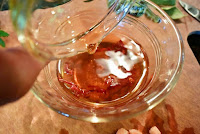The sweet and sour flavor of a spicy dressing or dipping sauce is a big appeal in warm or hot weather. While grilled eggplant, atsuage deep-fried tofu and shrimp make a great salad individually or in combination, pairing them with rice noodles makes a quick, filling meal. Grill eggplant and atsuage until slightly burnt for a stronger aroma! This is something similar to what I used to eat at a Vietnamese restaurant in Portland, Oregon, years ago.
1/2 of recipe:
473 calories; 21.8 g protein; 15.2 g fat; 62.5 g carbohydrate; 57.3 g net carbs; 439 mg sodium; 58 mg cholesterol; 5.2 g fiber; 636 mg potassium
Dressing only (including shami dried shrimp solids; 1/2 of recipe):
25 calories; 1.9 g protein; 0 (0.08) g fat; 4.5 g carbohydrate; 4.2 g net carbs; 375 mg sodium; 10 mg cholesterol; 0.3 g fiber; 49 mg potassium
<Ingredients>
1 long or 2 medium nasu eggplant (237 g Chinese eggplant in photo)
1 atsuage deep-fried tofu (112 g prep-boiled in photo)
6 shrimp (58 g shelled and cleaned with potato starch in photo)
30 g peanuts
5 g (approx. 2 tbsp) fried onion chips
Handful (30-50 g) cilantro (35 g in photo)
1 clove garlic
For dressing
4 g hoshiebi shami dried shrimp + 2 tbsp water (presoaked in photo)
1 tbsp nampla fish sauce
1 tsp kurozu brown rice vinegar
1/2 lime (or 2-3 tsp lime juice)
9-10 g sweetener of your choice (9 g agave syrup in photo)
2 taka no tsume red chili pepper (slices in photo)
2-4 kaffir lime leaves (to cook noodles; optional)
1.
Bring plenty of water to boil (to cook noodles).
2.
Devein and chop shami dried shrimp (save rehydration water).
3.
To shami dried shrimp rehydration water, add nampla, kurozu brown rice vinegar, sweetener (agave syrup), lime juice and taka no tsume red chili pepper, and mix well.
Set aside.
4.
Cut off top of eggplant, and poke skin (or make several cuts on skin lengthwise).
Grill until skin is somewhat burned (15-20 minutes on medium heat when using portable gas stove).
5.
In the meantime, dry roast peanuts on medium low heat until aromatic, 5 minutes or so.
6.
Snip cilantro leaves, and put stems in a tea bag (photo blow; to put in cooking water for noodles).
Grate garlic..
Put shrimp on skewers.
7.
When eggplant is halfway done, place atsuage and shrimp on the grill, and cook side by side.
8.
When water boils, add cilantro stems and kaffir lime leaves.
When vigorously boiling, put 500-800 cc in another pot (to reheat chilled noodles later).
Drain rice noodles, and cook until desired softness.
Drain, rinse, and chill in cold water.
9.
When eggplant is done, skin, and cut into several sections.
When atsuage is done, cut into several pieces.
10.
When ready to assemble, drain chilled noodles, pour over boiling water to heat noodles, and plate.
Put toppings (eggplant, atsuage, shrimp, peanuts, shami, garlic, cilantro leaves, fried onion chips), and pour over dressing.
Ready to serve.
<Notes>
- Poking skin or making cuts on skin of eggplant is to prevent the vegetable from bursting during grilling.
- Grilled eggplant skin can be easily removed by inserting a skewer or toothpick underneath skin and sliding it along skin. (See yakinasu grilled eggplant recipe for details.)
- Ideally, grilled toppings should be hot when serving. Noodles can be cooked in advance and chilled, and then heated immediately before toppings are done.
- If hoshiebi shami is not at hand, other Asian stock (such as chicken stock made without Western herbs, kobudashi kombu kelp stock, kaibashira dried scallop stock) or noodle cooking water (infused with cilantro, kaffir lime leaves, lemon grass, etc.) should work fine.
- Sodium content of fish sauce varies significantly by product (ranging from 700 mg to 1,800 mg per tablespoon). The product I use above contains 690 mg sodium per tablespoon.
- Kurozu brown rice vinegar (virtually sodium free) partially replaces nampla. If not available, regular rice or grain vinegar can substitute (but since its flavor is not as strong as kurozu, mixing in some shokoshu shaoxing wine would be helpful), or simply increase the amount of nampla.
- Hoshiebi shami I used above contains 450 mg sodium per 30 g.
- This tastes good with kinshitamago julienned egg crepes. In combination with julienned kyuri cucumber, this dish becomes closer to hiyashi chuka, cold Japanese-style Chinese noodles with an assortment of toppings.
(Last updated: July 23, 2018)


















No comments:
Post a Comment